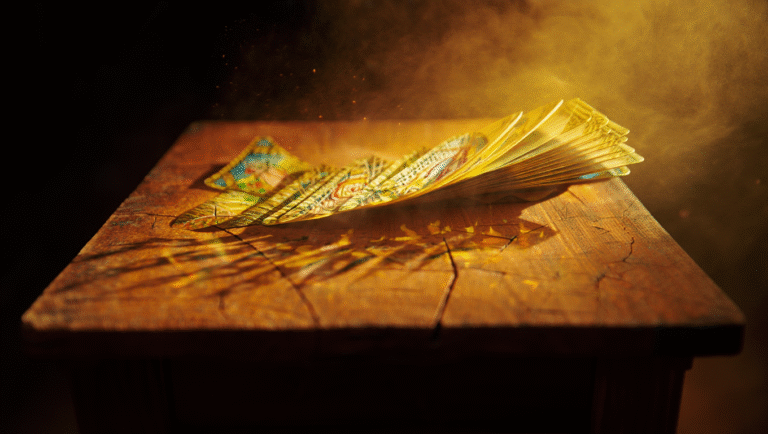Lesson 1: What Is Tarot and How It Works
If you’re curious about tarot but don’t know where to start, you’re in the right place. Forget the movie stereotypes—tarot isn’t about predicting doom or mysterious fortune-tellers in velvet. It’s a practical tool for self-reflection, decision-making, and mindfulness, and you can absolutely learn the basics in 15 minutes.
What Is Tarot, Really?
Tarot is a deck of 78 illustrated cards, each with unique imagery and symbolism. People use tarot for clarity, inspiration, and sometimes just to spark a good conversation with themselves or others. While some see it as “fortune-telling,” most modern readers (myself included) use it as a mirror: you ask a question, pull a card, and reflect on what that card’s imagery and message might mean to you. No supernatural skills required.
Tarot isn’t about telling the future. It’s about helping you see your present more clearly.
Let’s break down what’s in a tarot deck and how it works—practically, step by step.
Tarot Deck Structure: What’s Inside the Box?
Every standard tarot deck has 78 cards, divided into two main parts: the Major Arcana and the Minor Arcana.
Major Arcana (22 cards)
- Big themes and life lessons. Think of these as the “headline” cards: The Fool, The Lovers, The Tower, etc.
- They often represent key moments or major shifts.
Minor Arcana (56 cards)
- Everyday situations and details. This section is divided into four suits, kind of like playing cards:
- Cups – emotions, relationships
- Pentacles – finances, work, material life
- Swords – thoughts, communication, conflict
- Wands – creativity, action, ambition
- Each suit has cards Ace (1) through 10, plus four “court” cards: Page, Knight, Queen, King.
Pro tip: If you’re just starting, don’t stress about memorizing every card. Focus on noticing the imagery and your own first impressions.
How Does a Tarot Reading Work?
Forget the drama. Here’s a practical, no-nonsense breakdown:
- Ask a question. Example: “What energy should I focus on this week?”
- Shuffle the deck. You can shuffle however you like. Some people cut the deck; others just mix it up—no rules here.
- Draw a card (or several). For beginners, a single-card pull is perfect.
- Look at the card. What do you notice? What feeling or thought comes up?
- Read the meaning. Use the little booklet (“guidebook”) that comes with most decks, or check a reliable website. But also trust your gut.
- Reflect. How does this card relate to your question or life right now?
15-Minute Beginner’s Tarot Ritual
- Time needed: 15 minutes
- Materials: A tarot deck, notebook, pen
- Steps:
- Set a timer for 15 minutes.
- Take a deep breath. Ask yourself, “What do I need to know today?”
- Shuffle and pull one card.
- Write down the card’s name, your first impression, and what the guidebook says.
- Jot a sentence about how that message might apply to your life.
Best Tarot Decks for Beginners: Quick Comparison
| Name | Key Feature | Size/Material | Price range | Amazon link |
|---|---|---|---|---|
| Rider-Waite Tarot | Classic imagery, most guides use this | Standard size, cardstock | $15–$25 | Check price on Amazon |
| Modern Witch Tarot | Diverse, inclusive art | Thicker cards, modern look | $20–$30 | See today’s deal |
| The Light Seer’s Tarot | Vivid colors, intuitive imagery | Large, smooth finish | $20–$30 | Check price on Amazon |
How to Choose?
- Rider-Waite Tarot: Perfect for beginners, almost every guidebook uses this art. Pros: Easy to learn, tons of resources. Cons: Traditional, might not resonate with everyone.
- Modern Witch Tarot: Great for those who want modern, inclusive vibes. Pros: Empowering images. Cons: Slightly thicker cards, so shuffling can be tricky if you have small hands.
- The Light Seer’s Tarot: If you love color and intuition, this is your deck. Pros: Inspiring, relatable. Cons: Bigger size, so check if that fits your style.
Handy Tarot Resources for Beginners
- Biddy Tarot’s Free Beginner Guide – Clear, practical, and science-friendly.
- Labyrinthos Tarot Academy – Free online lessons and a great mobile app.
- The Light Seer’s Tarot Guidebook – Excellent for visual learners.
- Rider-Waite Tarot Deck with Guidebook – Classic starter set.
Beginner’s Tarot Checklist
- Choose a deck you like visually
- Get a guidebook or bookmark a reliable online resource
- Set aside 15 minutes for your first reading
- Have a notebook or app for your reflections
- Remember: There are no “wrong” questions or draws! Tarot is about learning and reflection.
“The most important thing is to stay curious. Tarot is a tool for you, not a test.”
In a Nutshell
Tarot is simple, visual, and practical. You don’t need psychic powers, just a willingness to be honest with yourself. Start with a deck that feels good in your hands, ask real questions, and notice what comes up. You might be surprised by how insightful (and fun) it can be.
Want to get started? Pick up a deck, set a timer, and try a single-card draw today. For more tips, resources, and product reviews, check out the links above!
This post may contain affiliate links. If you purchase through them, it won’t cost you extra, but it helps keep this site running.


